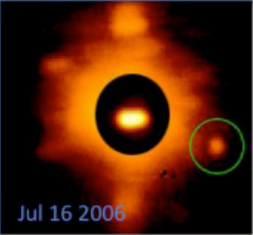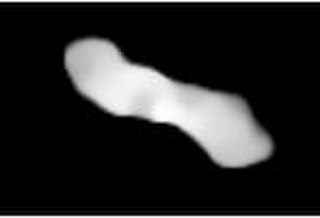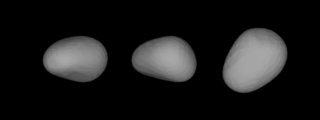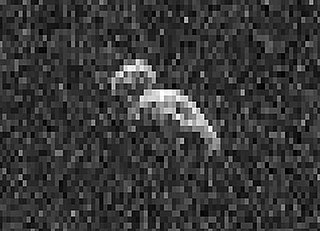
In astronomy, a contact binary is a binary star system whose component stars are so close that they touch each other or have merged to share their gaseous envelopes. A binary system whose stars share an envelope may also be called an overcontact binary. The term "contact binary" was introduced by astronomer Gerard Kuiper in 1941. Almost all known contact binary systems are eclipsing binaries; eclipsing contact binaries are known as W Ursae Majoris variables, after their type star, W Ursae Majoris.

A minor-planet moon is an astronomical object that orbits a minor planet as its natural satellite. As of January 2022, there are 457 minor planets known or suspected to have moons. Discoveries of minor-planet moons are important because the determination of their orbits provides estimates on the mass and density of the primary, allowing insights into their physical properties that are generally not otherwise accessible.

A binary asteroid is a system of two asteroids orbiting their common barycenter. The binary nature of 243 Ida was discovered when the Galileo spacecraft flew by the asteroid in 1993. Since then numerous binary asteroids and several triple asteroids have been detected.
A binary system is a system of two astronomical bodies of the same kind that are comparable in size. Definitions vary, but typically require the center of mass to be located outside of either object.

624 Hektor is the largest Jupiter trojan and the namesake of the Hektor family, with a highly elongated shape equivalent in volume to a sphere of approximately 225 to 250 kilometers diameter. It was discovered on 10 February 1907, by astronomer August Kopff at Heidelberg Observatory in southwest Germany, and named after the Trojan prince Hector, from Greek mythology. It has one small 12-kilometer sized satellite, Skamandrios, discovered in 2006.

Steven Jeffrey Ostro was an American scientist specializing in radar astronomy. He worked at NASA's Jet Propulsion Laboratory. Ostro led radar observations of numerous asteroids, as well as the moons of Jupiter and Saturn, Saturn's rings, and Mars and its satellites. As of May 2008, Ostro and his collaborators had detected 222 near-Earth asteroids, including 130 potentially hazardous objects and 24 binaries, and 118 main belt objects with radar.

216 Kleopatra is a large M-type asteroid with a mean diameter of 120 kilometers and is noted for its elongate bone or dumbbell shape. It was discovered on 10 April 1880 by Austrian astronomer Johann Palisa at the Austrian Naval Pola Observatory, in what is now Pula, Croatia, and was named after Cleopatra, the famous Egyptian queen. It has two small minor-planet moons which were discovered in 2008 and later named Alexhelios and Cleoselene.

44 Nysa is a large and very bright main-belt asteroid, and the brightest member of the Nysian asteroid family. It is classified as a rare class E asteroid and is probably the largest of this type.

617 Patroclus is a large binary Jupiter trojan asteroid. It is a dark D-type asteroid and a slow rotator, due to the 103-hour orbital period of its two components. It is one of five Jupiter trojan asteroids targeted by the Lucy space probe, and is scheduled for a flyby in 2033.
Don Quijote is a past space mission concept that has been studied from 2005 until 2007 by the European Space Agency, and which would investigate the effects of crashing a spacecraft into an asteroid to test whether a spacecraft could successfully deflect an asteroid on a collision course with Earth. The orbiter was designed to last for seven years. The mission did not proceed beyond initial studies.

A contact binary is a small Solar System body, such as a minor planet or comet, that is composed of two bodies that have gravitated toward each other until they touch, resulting in a bilobated, peanut-like overall shape. Contact binaries are distinct from true binary systems such as binary asteroids where both components are separated. The term is also used for stellar contact binaries.
The Asteroid Impact and Deflection Assessment (AIDA) missions are a proposed pair of space probes which will study and demonstrate the kinetic effects of crashing an impactor spacecraft into an asteroid moon. The mission is intended to test and validate impact models of whether a spacecraft could successfully deflect an asteroid on a collision course with Earth.

(388188) 2006 DP14, provisional designation 2006 DP14, is a sub-kilometer sized, peanut-shaped asteroid on a highly eccentric orbit, classified as near-Earth object and potentially hazardous asteroid of the Apollo group. This contact binary was discovered on 23 February 2006, by astronomers of the LINEAR program at the Lincoln Laboratory's Experimental Test Site near Socorro, New Mexico, in the United States. On 10 February 2014, it passed 6.25 lunar distances from Earth. The asteroid is approximately 400 meters in diameter and has a rotation period of 5.77 hours.

(85989) 1999 JD6 (provisional designation 1999 JD6) is an Aten asteroid, near-Earth object, and potentially hazardous object in the inner Solar System that makes frequent close approaches to Earth and Venus. On the Earth approach in 2015, it was observed by the Goldstone Solar System Radar and found to be a contact binary with the largest axis approximately 2 kilometers wide, and each lobe about 200–300 meters large. Although 1999 JD6 in its current orbit never passes closer than 0.047 AU to Earth, it is listed as a potentially hazardous object because it is large and might pose a threat in the future.

VFTS 352 is a contact binary star system 160,000 light-years (49,000 pc) away in the Tarantula Nebula, which is part of the Large Magellanic Cloud. It is the most massive and earliest spectral type overcontact system known.

(671294) 2014 JO25 is a near-Earth asteroid. It was discovered in May 2014 by astronomers at the Catalina Sky Survey near Tucson, Arizona - a project of NASA's NEO (Near Earth Object) Observations Program in collaboration with the University of Arizona.

(300163) 2006 VW139 (provisional designation 2006 VW139, periodic comet designation 288P/2006 VW139) is a binary active asteroid and main-belt comet from the outer regions of the asteroid belt. The object was discovered by Spacewatch in 2006. Its binary nature was confirmed by the Hubble Space Telescope in September 2016. Both primary and its minor-planet moon are similar in mass and size, making it a true binary system. The components are estimated to measure 1.8 kilometers in diameter, orbiting each other at a wide separation of 104 kilometers every 135 days.

2017 YE5 is a binary pair of asteroids of approximately equal size and mass, each about 0.9 km (0.56 mi) in diameter. Classified as a near-Earth asteroid and potentially hazardous object of the Apollo group, 2017 YE5 was discovered by amateur astronomer Claudine Rinner at the Oukaïmeden Observatory on 21 December 2017. On 21 June 2018, the pair of asteroids passed within 15.5 lunar distances or approximately 6 million km (3.7 million mi) from Earth. During the close encounter, 2017 YE5 was resolved in high detail by concurrent radar observations by the Arecibo and Green Bank observatories, along with individual observations by the Goldstone Solar System Radar. 2017 YE5 is likely an extinct or dormant comet due to its distant elliptical orbit and dark red surface.

Hera is a spacecraft developed by the European Space Agency for its space safety program. Its primary mission objective is to study the Didymos binary asteroid system that was impacted four years earlier by the NASA Double Asteroid Redirection Test (DART) spacecraft and contribute to validation of the kinetic impact method to deviate a near-Earth asteroid from a colliding trajectory with Earth. It will measure the size and morphology of the crater created as well as the momentum transferred by an artificial projectile impacting an asteroid, which will allow measuring the efficiency of the deflection produced by the impact. It will also analyze the expanding debris cloud caused by the impact.













